Hoshiarpur district is located in the foothills of Shivaliks in the northeastern part of the State. It has two distinct regions: Kandi tract (Sub-mountainous area) and Non-Kandi Area (Plain area). The Kandi tract includes four under-developed blocks- Bhunga, Dasuya, Hajipur and Talwara, and three relatively developed blocks- Hoshiarpur-I, Mahalpur and Garhshankar blocks. This area is on the upstream side of the Pathankot-Dasuya-Hoshiarpur-Chandigarh road. The second area is below the Kandi tract. It is totally plain and is comprised of Mukerian, Tanda and Hoshiarpur-II blocks. These blocks are mostly well-developed.

The major problems faced by the people of Kandi tract are erratic distribution of rainfall, lack of irrigation facilities, heavy soil erosion, landslides and declining soil fertility. This has resulted in the poorer availability of green fodders and drinking water for various livestock species in the area. The ever increasing human population has further intensified the demand of drinking water.
Water is one of the most important components of animal’s diet. Majority of body reactions take place in the aqueous phase of the protoplasm of various cells. Digestion, absorption and assimilation of food particles, excretion of waste material, homeothermy of body, vision, smooth functioning of joints are all dependant on water. Milk yielding potential of a particular animal is influenced by the water intake level. This is simply because of the fact that milk contains almost 85-87 per cent water.
The daily water requirement is different in different livestock species. This is because of variable level of water losses. The daily water requirement is determined by the age of animal, its genetic constitution, pregnancy status, production status, management strategies, environmental factors, quality of water and quality of feed/ fodder.
Because of limited availability of water resources, drinking water is usually considered equivalent to elixir of life. It should always be used very judiciously. Its wastage in any form should be checked. The animals fulfill their water needs by drinking water as such or through fodder intake. Small amount of water is also produced during metabolism. Drinking water from any source is by far the most important method of quenching one’s thirst.
Majority of livestock farmers in lower parts of kandi area of Hoshiarpur district rely on ground water. This ground water is mostly extracted out by hand pumps. Since the livestock farmers in kandi area are small and marginal farmers, they possess on an average 2.3 Adult Cattle Units (ACU) per family. Because of smaller herd size, the overall water requirement of whole of the herd is very small. This demand can be easily fulfilled be drawing ground water with the help of a hand pump.
Tube well is also employed to extract water in areas where ground water is not too deep. The animals are allowed to drink water from a shallow reservoir. Whenever the agricultural fields are irrigated, the animals are let loose to quench their thirst. Even when the irrigational demands are over, the tube wells are run particularly for the livestock. At certain places a pucca reservoir has been constructed for the purpose.


At certain relatively big farms, pucca water troughs have been made. The breadth and depth of this trough is usually five feet and three feet, respectively. Its length will depend on the size of the herd. One cubic foot of this trough can hold about 28 litres of water. Each animal of the herd must have access to about 60 litres of water in the trough. These figures will help the farmer to evaluate the size of the trough sufficient for his own herd.
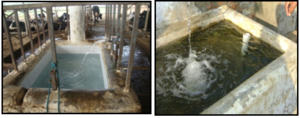
The state government has made special efforts to bring potable water to such villages where ground water is not accessible especially in upper reaches of kandi area.
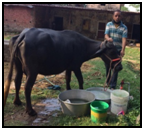
Historical wells are available in certain villages of kandi area. Water from such wells is still being used for human and livestock needs. Water is usually extracted out with buckets manually. For this purpose, a person has to descend up to water level in the well through a specially constructed staircase.
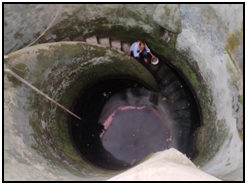
Special canals have been constructed in the kandi tract of Hoshiarpur district to cater to the irrigational needs of the area. Kandi canal is by far the backbone of the area. It takes off from Mukerian hydel channel and runs along the Shivalik foothills. The first phase of its construction got accomplished in 1998. During this phase, it was completed up to a distance of about 59.0 km. It utilizes 242 cusecs of water providing irrigation facilities to 19867 hectare of area benefiting 215 villages exclusively in kandi area of Hoshiarpur District. The villagers living alongside this kandi canal (especially on its right bank) fulfill their water needs by drawing water from this very canal. Special ramps (cattle ghats) totalling 27 in number have been constructed for the animals to drink water from this canal. The most important feature of these ramps is that the animal can drink water, but they cannot enter the canal itself. This way, the water body remains pollution free. The distribution system of this canal comprises of 46 head regulators, 11 distributaries (length 60.70 Km) and many minor water courses/field channels (length 610 Km).

There are a few choes in kandi belt that flow for substantial part of the year. River Beas flows just along the border of Hoshiarpur district. Water from such rivulets can be employed for livestock as well as for domestic use.
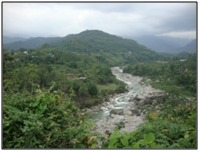
In kandi area, the slope gradient is too high. The rain water gushes down the hill too quickly, often, causing soil erosions, flooding, uprooting of trees etc. Small check dams have been constructed at suitable places to collect this rain water. This water is, then, channelled to various households down the hill through gravity. A total of nine such dams have been constructed in the kandi area of Hoshiarpur district. These dams are called Dholbaha dam, Maili dam, Janauri dam, Damsal dam, Chohal dam, Thana dam, Saleran Dam, Patiaria Dam and Nara Dam.

The rain water collected in village ponds can also be employed for future use in animal farming. However, quality of water from such bodies has to be ensured before using it for drinking purposes. Many a times, pond water contains toxic matter that can be hazardous for animal health.
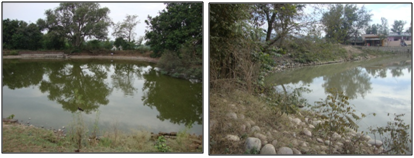
The rain water can even be collected in ditches excavated in the farmer’s fields. The seepage of water can be prevented by lining these trenches with polyethylene sheet. The water so collected can be used for irrigating the adjacent fields. The grazing animals can also quench their thirst by drinking water from such ditches. Rain water can also be harvested from rooftops of various households which can be used for animal husbandry.
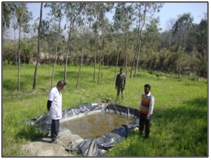
The farmers especially in kandi areas, thus, can improve their agricultural as well as livestock output through judicious utilization of available water resources. The farming can even become more profitable when the optimum production level is maintained for a longer period through better management of drinking water.

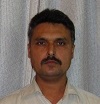


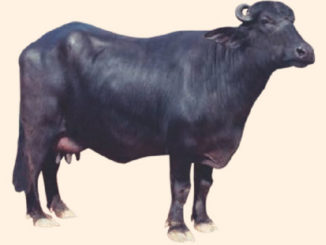
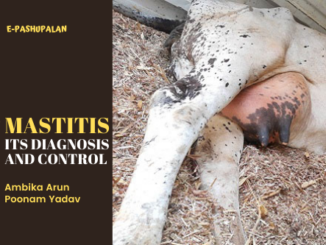


Be the first to comment